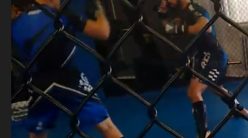There are a number of ways to increase your punching power. But, the most important way initially is to cultivate good form.
In talking about good form, we’ll start with alignment and work from there.
Bone Alignment
With good form, you derive your power from proper bone alignment. From there, any of the other key attributes you develop will just multiply this effect. It came from proper alignment.
Leverage
It starts in your base. Many people neglect this. You need a pivoting, weight-shifting base if you want real follow-through punching power. This pivoting base is what transfers weight down at the feet and legs, which in turn sends the hip, which in turn sends the shoulder. When you throw a cross, for instance, turn your rear heel out (pivot on ball of foot), and shift your weight onto your front foot (toes pointing forward at this time).
We Lose Leverage At Our Joints
One of the most common faults in a person’s punching technique (which results in lost power) is that POWER IS LOST IN THE JOINTS. This usually means the shoulder, elbow, or wrist. All bones function as perfect transmitters of force, but where one bone ends and another begins is where we tend to lose it. Misaligned, over-tensed, or under-tensed joints will vent off your power. People who wing their punches, for instance, will tend to lose power at the shoulder and elbow.
People who bend their wrist when they hook, for another example, will tend to lose the power of that punch at the wrist.
Never “Lock Out” Your Punches
Power in a punch also comes from follow-through. You don’t lock out your punches. Same goes for kicks (although they look “prettier” when you do them that way). I know a lot of classically trained martial arts teach you to lock out that “reverse punch”, but I would differ on that methodology. I spent time observing traditional martial arts, and I’ve spent a lot of years training around boxers and such. The latter hit much harder. A lot of it has to do with the follow-through allowed by a mobile, pivoting, weight-shifting, bent-knee base.
Relax
I always tell my students that “tension” is the opposite of everything good or favourable in your performance. Tension is the opposite of speed. Tension is the opposite of POWER. Tension is the opposite of nontelegraphy. Tension is also the opposite of mobility. Tension is a drain on endurance.
In the case of punching power, which is the subject at hand, it is TENSION IN THE SHOULDERS that most often diminishes not only one’s power, but also one’s ability to land the punch on an opponent – because of its effect on the aforementioned aspects of a successful punch (speed, nontelegraphy, mobility, etc.).
The Body Is What Punches, Not Just The Arm
When you hit someone, it should feel like a piano fell out of a second story window and hit him on the end of your fist. This is in keeping with info provided earlier in this post about shifting the weight, etc. The reason why you’re shifting your weight is SO THAT HE FEELS YOUR WEIGHT IN YOUR PUNCH. There’s a saying that a person who really knows how to hit moves fluidly but his touch is as heavy as a mountain. Sounds like good boxing to me. If your weight is settled on your feet, then that mass is not going into the punches.
Tight Fist
At the tail end of execution, the last place you can either add or lose power in a punch is in your fist itself. It should stay loose through most of your execution and tighten up just before impact.
The Snap – The Right Time and Place
The power of your punch is right on the end, where it snaps. This is true of ALL punches – not just your linear punches. The art of punching then becomes the art of coordinating your own body mechanics (which is most of what I talk about here) with the placement of your target AT PRECISELY THE RIGHT RANGE AT THE RIGHT TIME, where you hit target as your punch is snapping on the end. When you don’t get this right, your power is either jammed because the range and timing weren’t right, or it falls short or misses for the same reasons.
This, by the way, is one of several ways in which KEY attributes come together to equal success in your hitting. As far as the above paragraph, you get this ability from essentially two areas of training: sparring and fighting. Partner drilling will never in a million years give you this ability. Secondarily, you can get some aspects of this ability from focus mitt training and the double end bag (or crazy ball) – in both cases because they simulate either the chaos or the predictable flow of sparring and fighting, where through timing and range you get your punches to meet up with the target properly.
There’s more to this, in general, as far as learning to punch with power is concerned. Much of it, though, is difficult to convey in text. Much easier to show.
One last point for you is that you have to develop your kinesthetic perception if you really want to be able to hit with power. There is a correct sequence of muscular contractions for every punch, every kick, which happens very quickly in rapid succession. In addition to contractions, there is a correct series of RELEASES (very important) – i.e. when a certain muscle in the chain has done its job, and now needs to let go before it starts to hinder your function.






